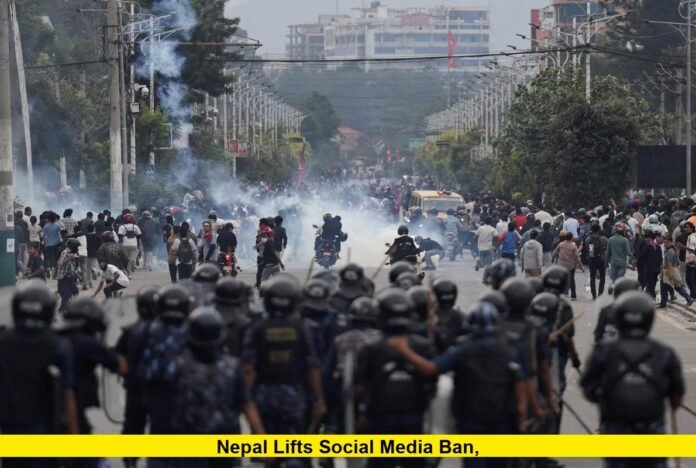Nepal lifts social media ban following days of unrest that shook the Himalayan nation and drew international attention. The government announced the reversal after violent clashes between security forces and protestors left at least 19 people dead and hundreds more injured.
The restriction, first imposed on September 4, 2025, had blocked 26 popular platforms, including Facebook, Instagram, WhatsApp, X (formerly Twitter), YouTube, and Snapchat. Officials argued that companies had failed to register under new regulations, but for citizens—particularly young people—the ban was seen as an assault on freedom of expression and an attempt to silence dissent.
The Ban That Sparked Nationwide Outrage
The decision to block access to social media instantly disrupted communication across Nepal. Families, businesses, students, and journalists suddenly found themselves cut off from the digital networks that connect them to both local and global communities.
The ban particularly angered Gen Z users, who rely heavily on these platforms not just for entertainment, but also for education, organizing, and activism. Their frustration quickly spilled onto the streets of Kathmandu and other major cities. Demonstrators carried placards, shouted slogans, and demanded that the government restore online freedoms and address deeper issues of corruption and governance.
Protests Turn Deadly
On September 8, protests reached a boiling point. Thousands of young people gathered near the parliament, chanting against corruption and calling for the return of their digital rights. Security forces responded with tear gas, water cannons, rubber bullets, and in some cases, live fire.
The result was tragic: at least 19 demonstrators lost their lives. Hospitals across Kathmandu were overwhelmed with hundreds of injured protestors, many of them students. Families of victims publicly expressed grief and anger, further intensifying public outrage.
The violence shocked the nation and prompted calls for accountability. Amid the escalating crisis, Home Minister Ramesh Lekhak resigned, acknowledging political responsibility for the crackdown.
Emergency Meeting and Reversal of the Ban
Facing mounting domestic and international pressure, Nepal’s cabinet held an emergency meeting on September 9. Shortly after, Communications Minister Prithvi Subba Gurung announced that the ban had been withdrawn.
“We have withdrawn the shutdown of social media. They are working now,” the minister confirmed.
By the afternoon, Nepalese citizens were once again able to access Facebook, Instagram, YouTube, and other platforms. The return of connectivity was met with relief, but also with lingering anger about the government’s heavy-handed approach and the high cost of restoring these freedoms.
Prime Minister Oli’s Response
Prime Minister K.P. Sharma Oli addressed the nation following the bloodshed. He expressed sorrow over the deaths and pledged government support for victims’ families, including compensation and free medical treatment for the injured.
The Prime Minister also announced the formation of an investigative panel tasked with reporting within 15 days. He attributed part of the unrest to alleged external influences but acknowledged that mistakes had been made. His refusal to resign, however, drew criticism from protest leaders and opposition figures who argued that real accountability requires leadership change.
Global Condemnation
The deadly crackdown drew widespread condemnation from rights organizations and foreign governments. Observers criticized the excessive use of force against unarmed demonstrators and urged Nepal to ensure freedom of speech and peaceful assembly.
For the international community, Nepal’s decision to ban—and then restore—social media highlights the fragility of digital rights in emerging democracies. It also serves as a reminder of how closely tied internet freedom is to broader political stability.
Why This Matters to U.S. Readers
For readers in the United States, Nepal’s crisis holds broader implications:
- Nepali Diaspora in the U.S.
Many Nepalese Americans depend on platforms like WhatsApp, Facebook, and YouTube to stay in touch with loved ones back home. The ban disrupted those vital connections. - Global Internet Freedom
The events in Nepal illustrate how quickly digital restrictions can lead to social unrest. As debates continue in the U.S. about tech regulation and platform accountability, Nepal offers a stark case study. - Youth Movements
The protests were driven by Gen Z, a generation increasingly influential worldwide. Their determination shows how digital natives can mobilize for rights that go beyond borders.
What Comes Next for Nepal
While the lifting of the social media ban brings immediate relief, the underlying issues remain unresolved. Protesters are demanding:
- Stronger anti-corruption measures.
- Assurance that freedom of expression will be protected.
- Accountability for the use of lethal force against civilians.
The government’s willingness to listen to these demands will determine whether Nepal can restore public trust—or whether the crisis marks the beginning of deeper instability.
A Turning Point for Digital Rights
The reversal of Nepal’s ban is more than just a policy change; it represents a critical turning point for digital freedoms in South Asia. The protests proved that in today’s interconnected world, shutting down communication platforms can ignite greater unrest than it prevents.
For Nepal, the challenge now lies in balancing regulatory goals with the rights of its people. For the rest of the world, especially democracies like the United States, the episode is a vivid reminder that the fight for digital rights is far from over.
Closing Thoughts
Nepal lifts social media ban, but the scars left behind are fresh. Nineteen lives were lost, countless others were injured, and the trust between citizens and the state has been deeply shaken. The events of September 2025 will likely be remembered as a defining moment for Nepal’s democracy and its youth-led movements.
What do you think—will Nepal’s leaders make meaningful reforms, or will this simply be another temporary concession? Share your thoughts and join the conversation below.
